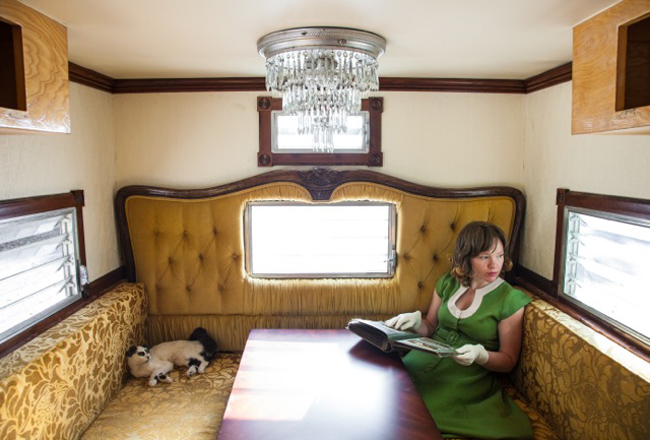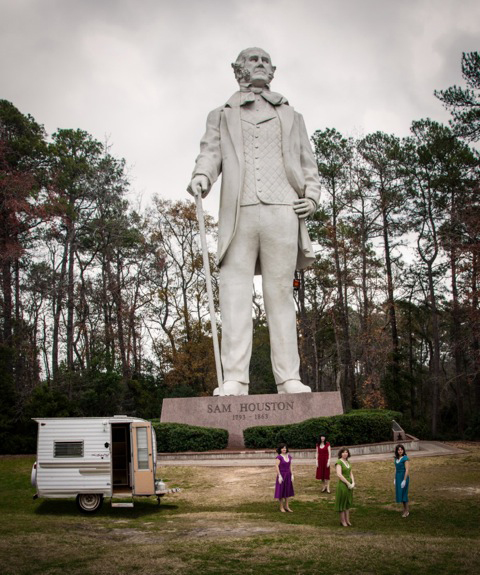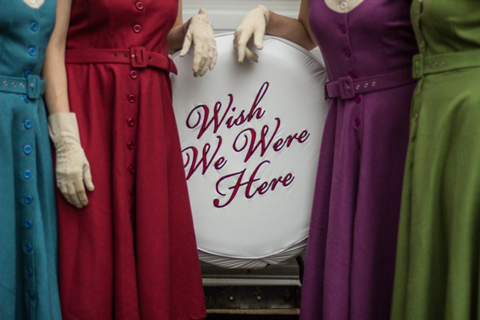Art Prof Explores 'Home' Through Her 'Trailer' Project
Feb. 25, 2013
SHSU Media Contact: Meredith Mohr
 |
| Assistant professor of art Annie Strader in her role within "The Trailer." The performance art project examines the concept of "home" and the various ways people can define "home." In looking through the scrapbook, Strader and the other Bridge Club performers remember the past and hope to actively engage visitors to do the same. "The Trailer" will tour the country, kicking off at the Lawndale Art Center in Houston on March 21. —Submitted photos |
On the outside, it appears to be a plain vintage Cardinal camping trailer from 1969, with a simple structure and inviting light next to the door.
But upon closer examination, there are telltale signs of what lies inside: an ornate doorbell installed on the side of the trailer next to the door, as if inviting curious visitors to explore further, leads guests to a completely restored interior that reflects a 19th century Victoriana style, with a tufted headboard, wallpaper, hardwood floors, crown molding and a crystal chandelier. A taxidermy cat even lounges on the bench seating inside the trailer.
The outside reflects ideas about travel, discovery and the American practice of “touring,” but the inside speaks of familiar and sometimes impractical, yet house-like, elements that define what “home” is.
Both ideas drive home the goals The Bridge Club hopes to accomplish with their most recent project, “The Trailer.”
The Bridge Club is a contemporary visual art collaborative consisting of Sam Houston State University assistant professor of art Annie Strader and artists Christine Owen, Emily Bivens and Julie Wills. For Strader, this group serves as a way to translate academic research into artistic expression but also to explore and grow in the field of performance art.
With “The Trailer,” The Bridge Club aims to characterize and explore what people across the United States define as home, a definition, Strader said, they expect to be “diverse and expressive of the local peculiarities” of each place they take the trailer.
To discover the meanings of home in the perspectives of many people and places across America, The Bridge Club will tour the country in the remodeled and reimagined camping trailer, bringing a series of live performances to both major metropolitan cities with significant arts programs, as well as rural cities and lesser-known places along the way, including truck stops to farmer’s markets.
“In the United States, people are constantly being displaced by natural disasters or other circumstances,” Strader said. “Their sense of home is being changed as they move around, sometimes with only a few of their most important possessions. They have to make ‘home’ portable, and it isn’t always practical. We thought about how memories can be possessions that are collected along the way that make up what a person believes is a real representation of home, which is unique to them.
“One of the most important things about this project and its goal is to bring the ideas we are exploring to everyone, for a diverse perspective on what home is,” she said. “As the project develops, we are including people and places in this dialogue that might not be included in a traditional art setting normally. Everyone—no matter how much they know about art—has a valuable sense of what home is. We also think that every place has something to contribute to this sense.”
 |
| "Home is where the heart is:" (above) The Bridge Club's art project "The Trailer," which found a temporary home in Huntsville. (Below) Through the project, Strader and her Bridge Club hope people will think about the concepts of "home" and the past. |
 |
People who come to view “The Trailer” as it tours the country will be invited to participate in the work as performance art by submitting stories through The Bridge Club’s website or by bringing objects that will be curated in cabinets with glass doors in the trailer itself. Strader said she hopes this aspect will nurture the idea of “collecting” in their project.
“We are more interested in the stories that people have to tell—about objects that have meaning to them, their family members, pets—from their own regions of the country,” Strader said. “At the end, we hope to have something collaborative that reflects the local flavor of all the places we have taken the project to.
“The idea here is to think about things that people deem important and about their regional differences and similarities.”
While on display, each Bridge Club member will perform activities related to remembering the past—such as looking at a scrapbook—or planning future experiences and will seemingly not acknowledge their current locale. Performances will not be scripted, or include dialogue, but will incorporate site-specific alterations to the trailer (such as rotating the collection of donated objects) and will be based on audience, geography and context.
Through these performances, Strader said, the club hopes to express in a visual manner, lived and collected experiences and show the importance of the role of memory in authenticity and familiarity.
She explained that performance art is used by artists across a range of disciplines to reach a broad audience and to blur the boundaries between traditional art forms. It employs performances of varying kinds to address current artistic, political and social issues of the time and explore artistic ideas in a live action setting.
“Performance art is a medium that inherently rejects definition,” Strader said. “Emerging artists and arts writers are constantly expanding the scope of how it is understood or defined. Performance refers to work that has originated in the traditions of theater while performance art refers to artists who utilize a particular discipline or disciplines in ways that have nothing to do with training in that field.”
The Bridge Club, Strader said, relies on a series of rules or predetermined logic that guides them through a performance.
“We never know how an audience will respond or what exactly will happen during the performance,” Strader said. “We are interested in the intuitive nature of action and response and the notion of chance.
“In our performances, we pay particular attention to the associations and metaphors that emerge through our choice of materials, objects and actions in a space rather than leading the viewer to make specific conclusions about what they see,” she said. “That bit of ambiguity in the work is intentional and is the place where the viewer is able to craft relationships between their experience of our work and their own outside experiences and understandings.”
Strader, who obtained a Master in Fine Arts from the University of Colorado in Boulder, first found an interest in performance art after taking a seminar class about using objects as props. She has been performing with The Bridge Club since 2004, as well as working individually and in collaboration with her colleague and full-time lecturer of art Matthew Weedman to create video and sculptural installations and objects.
“My degree is actually in ceramics, but one semester I took this seminar class and learned about the history of performance art,” Strader said. “I met the other women in The Bridge Club in our classes as MFAs in ceramics. We were all friends and found ourselves interested in objects and the way they hold information and communicate ideas. Putting objects into action, so to speak, through performance art, seemed like a natural extension. The individual work we were doing had some overlaps with each other, so we tried it out as a group project and it worked.”
Her work in performance art is, she said, equivalent to what is considered “academic research” such as publications or presentations in other disciplines. Exhibitions, performances, and screenings of creative work constitute research in a creative field and contribute new developments to the art field, she said.
But it is her love of the challenge of performance art that seems to be put into practice with “The Trailer,” a new style of project for them that “is always fluid and changing, like performance art always is.”
“I love that about performance art,” Strader said. “The fact that performance art can happen anywhere is really interesting, to me. I find that my work will change with the venue and location but there is still the undercurrent of the theme of the project that I am working on that stays the same. Each time I do a performance there is a fresh energy and new feedback that comes from your audience.”
“The Trailer,” which will be on-going over the next few years, will kick-off at the Lawndale Art Center in Houston on March 21, from 2-4 p.m. and 6-8 p.m. On March 22-23, “The Trailer” will be at non-art locations around Houston.
The project is supported through an Idea Fund grant from The Andy Warhol Foundation for the Visual Arts and an enhancement research grant from the SHSU Faculty Research Council. These grants will fund various aspects of travel and upkeep of the trailer.
“Without their support, none of this project would be possible,” Strader said. In the fall, they hope to travel to Austin and San Antonio, stopping at a few rural towns in between.
Interested participants can submit their stories and find out more information through the project’s website, at www.bridgeclubtrailer.com.
- END -
This page maintained by SHSU's Communications Office
Associate Director: Julia May
Manager: Jennifer Gauntt
Located in the 115 Administration Building
Telephone: 936.294.1836; Fax: 936.294.1834
Please send comments, corrections, news tips to Today@Sam.edu.

 SamWeb
SamWeb My Sam
My Sam E-mail
E-mail

